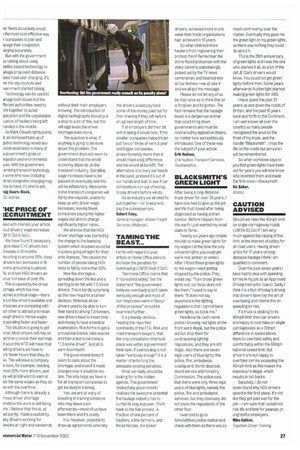HE PRICE OF IECRUITMENT
Page 27

If you've noticed an error in this article please click here to report it so we can fix it.
ead with interest your article iout drivers' wage increases l'A431 Oct-6 Nov).
We have found it necessary give class C+E drivers two 3reases in 13 months
flaunting to around 20%; class drivers two increases in 18 onths amounting to almost %; and non-HGV drivers an inual increase of over 8%. This is caused by the driver large, which has now
ached a crecal stage—there e too few drivers available and impanies are competing with ich other to attract and retain lough drivers. Hence wages a spiralling faster and faster. This situation is going to get rse. Most drivers still rely on iertime to boost their earnings it soon the MD will mean that tting drivers will have to Drk fewer hours than they do w. This will leave a company e ours, for example, needing Rost 20% more drivers, and ey will all still want to earn at 1st the same wages as they do w with the overtime. Although there is already a rims driver shortage imehow the work is still being ire. I believe that this is, at 1st partly, made possible by any drivers working for encies at night and weekends
without their main employers knowing. The introduction of digital tachographs should put a stop to a lot of this, but this will aggravate the driver shortage even more.
The question is what, if anything is going to be done about this problem. The government does not seem to understand that the whole economy depends on the transport industry. Spiralling wage increases have to be passed on eventually and this will be inflationary. Meanwhile some transport companies will fall by the wayside, unable to keep up with driver wage increases, leaving fewer companies paying the higher wages but able to charge significantly higher rates.
We all know that the HGV driver shortage was started by the change to the licensing system which stopped would-be truckers going straight for their artic licences. This caused the number of people taking 1-10/ tests to fall by more than 50%.
Now the shortage is spreading down the line and is starting to be felt with 7.5-tonne drivers. This is hardly surprising as this now requires a career decision. Whereas all car drivers used to be able to turn their hand to driving 7.5-tonners, new drivers have to invest time and money to have a medical examination, fill in forms to get a provisional licence, take lessons and then a test to be come a "7.5-tonne driver". And all to earn howmuchP The government doesn't seem to care about the shortage, and even if it made changes now it would be too late. The only hope we have is for all transport companies to get involved in training.
Yes, we are all wary of investing in training someone who may leave soon afterwards—most of us have been there and it's costly.
his, however, possible to draw up agreements whereby the drivers would pay back some of the money paid out for their training if they left before an agreed length of time.
If all employers did their bit with training it would help. If the smaller companies helped train just two or three drivers a year and bigger companies proportionately more then it would make a big difference and we would all benefit. The alternative is to bury our heads in the sand, pretend it's out of our hands and wait to see if our competitors run out of money to pay drivers before we do.
As an industry we all need to pull together—or prepare to pay the consequences.
Robert Ialey,
General manager. Mobile Freight Services (Midlands).




























































































































































